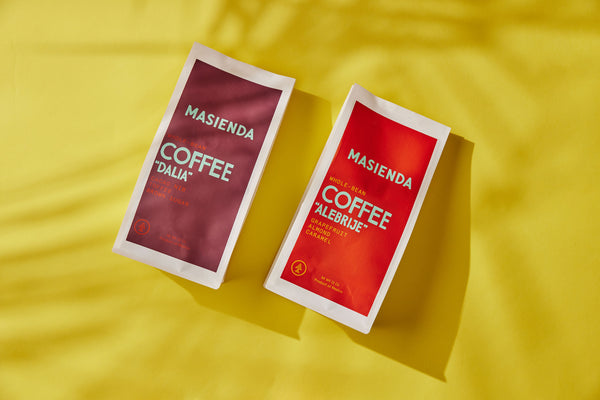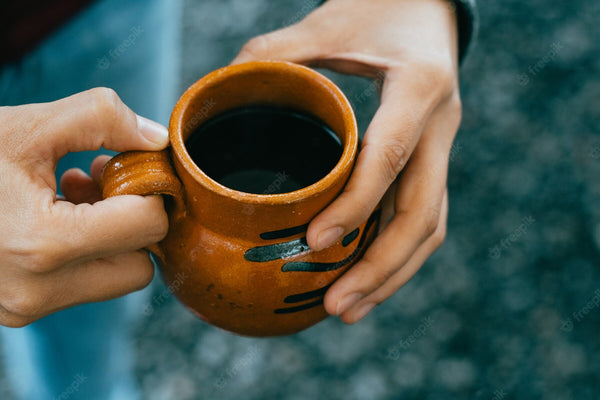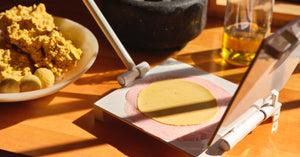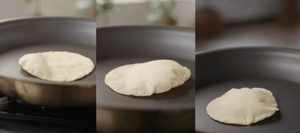Three Mexican Coffee Drinks to Jumpstart Your Morning ... Or Night
Three Mexican Coffee Drinks to Jumpstart Your Morning ... Or Night

August 25, 2022
As the specialty coffee scene in Mexico grows, US cafés are taking note and incorporating traditional beverages into their offerings. Three classic drinks—café de olla, the carajillo, and horchata—are getting top billing on menus or, in the case of horchata, makeovers in the form of an extra jolt of caffeine.
As far as Masienda’s BUNA coffee offerings are concerned, we like the Dalia blend for café de olla (thanks to its smooth, chocolatey flavor) and cafe-chatas, and the bright, citrusy Alebrije blend for carajillos. Either blend can be ground for drip coffee or espresso.

Café de Olla
What is it?
The name “café de olla” means “coffee from a pot.” The pot, in this case, is typically a clay vessel which both retains heat and imparts a bit of its earthy flavor into the coffee.
Café de olla is a traditional method of preparation that varies in its exact recipe, but consists of ground coffee and spices (usually cinnamon and piloncillo, but sometimes also orange peel, anise, cloves and even chocolate) brewed together in a clay pot. The drink reminds many Mexican coffee drinkers of home, and conjures a cozy, hot chocolatey feeling.

Origins
Café de olla is a drink steeped in history. Although there isn’t much concrete evidence surrounding its origins, the popular story is that it was invented during the Mexican Revolution in the early 1900s.
As legend goes, adelitas (revolutionary women, named after Adela Velarde Pérez, a nurse who played an important role in helping injured soldiers), who were charged with cooking, cleaning and setting up the soldiers’ camp, created the sweet, spiced drink to warm the bellies of soldiers during long, cold nights at camp and boost their stamina. Perhaps it was a clever way to stretch rations by doctoring up old, reheated coffee, and also served to suppress hunger while imparting nutrients.
How to make Café de Olla
Recipes differ by region, and from family to family, but it is most traditionally prepared by boiling water with a stick of cinnamon and other spices before adding ground coffee and piloncillo (unrefined cane sugar).
According to the blog Perfect Daily Grind, in Veracruz, a coffee-growing region, the ground coffee, sugar and spices are wrapped in a cloth (like a bouquet garni) before being steeped. In the south of Mexico, café de olla often includes the peel of citrus like orange or lemon, along with aniseed.
Modern takes
Café de Leche in northeast Los Angeles serves their version of café de olla, which they call the Cafe Campesino (the term for a peasant farmer), in both coffee and latte versions (the latter of which uses espresso instead of ground coffee), spiced traditionally with cinnamon, piloncillo, anise and orange peel. Mexico City’s Cafè Kumo offers a café de olla syrup to add the warming flavors of piloncillo and cinnamon to coffee beverages. New York City’s Atla features the flavors on their dessert menu in a Café de Olla flan.
Carajillo
What is it?
The Mexican version of the carajillo, a cocktail that originally hails from Spain (or possibly Cuba, depending on who you ask), is a drink made from espresso and Licor 43, a liqueur named for its 43 ingredients including citrus fruits, herbs and spices, and heavy on the vanilla flavor. The finished cocktail’s flavor is almost like a coffee milkshake.
It’s been a staple of old-school restaurants and cantinas for ages. According to Michael Snyder for Punch, “For decades, practically the only people drinking carajillos in Mexico were members and descendants of the Spanish diaspora, who would gather for elaborate, formal lunches.” Thanks to the city’s juniors, or moneyed young elite, the carajillo was adopted as the ideal pre-game drink, and now is thought of as the best way to perk up after Mexico City's famous long, late lunches (comidas). Your espresso martini could never.
Now, swanky cocktail bars and specialty coffee shops alike sport versions of the classic on their menus.

Photograph courtesy of Suerte
Origins
Most theories point to Spain as the origin of the carajillo, around the time of the conquest. There are also reports positing that it first appeared in Cuba or Catalonia.
In its likely-native Spain, the carajillo is an early-morning drink in the bars of working class neighborhoods, like the Spanish version of an Irish Coffee.
One version of the story goes that when Cuba was a province of Spain, the Spanish soldiers drank spiked coffee to give themselves courage (coraje) in their battles against the indigenous population. Or it could have been coffee and rum, given to indentured laborers on Cuban plantations. Coraje, carajillo ... see the connection?
Another theory posits that the name originated in Andalusia, where, according to Punch, morning drinking is commonplace. The name might be a diminutive for the expletive “carajo!” (a more colorful way to say “screw it!”), which is what you’d be tempted to yell just before downing a carajillo.
A third story hails from Catalonia, where carriers who moved goods between towns would order up a spiked coffee que ara guillo–old Catalan slang for “in a hurry.”
How to make a Carajillo
In Spain, carajillos might be made with brandy, rum, or whiskey. In Mexico, carajillos are always made with Licor 43, and typically offered either puesto (on the rocks, with the espresso floating above the liqueur) or shakeado (shaken, or whipped in a cocktail shaker then poured over ice). We like it best made with a prepared shot of espresso and 1 part Licor 43, shaken and quickly strained over ice.
Modern takes
Mexico City’s Cicatriz Café serves a gussied-up version, featuring brandy and cream alongside the classic espresso and Licor 43, highlighting the already milkshake-like flavors of the cocktail. Suerte in Austin offers a carajillo cocktail using a combo of cold brew concentrate and coffee liqueur, along with the classic Licor 43. They also always have a seasonal variation of a carajillo on the menu: the spring-summer version is the Carajito, a mashup of the carajillo and mojito that adds a blend of rums, amaro, mint, and spiced cocoa bitters to the classic carajillo base.
To start with cold brew base, we'll give the floor to our low-key coffee expert Eric Sugatan:
Cafechata
What is it?
Horchata, the sweet, creamy agua fresca has a myriad of spinoffs throughout Latin America, one of which is the rice-based Mexican version (horchata de arroz) we know best in America, usually featuring cinnamon and sugar. As horchata’s popularity rises and people learn about its many variations, specialty coffee shops have started offering their own take on the classic drink: an amalgam NY Magazine called “both delicious and divisive.” The cafechata (also known as the café con chata, horchoffee, horchata latte or dirty horchata) can be served cold or hot, and is spiked with a shot of cold brew concentrate or espresso.

Photograph by Adam Friedlander, courtesy of For All Things Good
Origins
Horchata is such a standard offering at taquerias and Mexican restaurants that you may have assumed its roots are Mexican, but this drink can actually be traced back to ancient Rome, North Africa and Spain. According to Atlas Obscura, “While the Mexican version of the drink first appeared in the 16th century, its roots date back to an ancient Roman medical elixir made from barley. In fact, the word horchata comes from the Latin hordeum (barley) and hordeata (drink made with barley). From its role as medicine in antiquity, the beverage took a circuitous route across Europe and across the Atlantic to Latin America. Along the way, horchata became a whole family of drinks made from various grains, nuts, and seeds.”
The horchata we know in America came from Spain, where “horchata de chufa” (made from ground, sweetened tiger nuts), a tuber imported by the Moors from North Africa) was the preferred beverage. When the Spaniards conquered Mexico in the 16th century, they brought rice, sugarcane and cinnamon with them, but left the tiger nuts at home. Thus, horchata de arroz was born.
Legend has it that the name for the drink dates back to Valencia in the 13th century, when King James of Aragon was offered a glass. After tasting it, he exclaimed to the woman who served it to him, in Valencian dialect “Aixó es or, xata!” (roughly translated to “this is gold, girl!”), according to Atlas Obscura.
Variations of the drink abound, even within Mexico (some versions feature dried cantaloupe seeds, coconut, barley and more). Puerto Rican and Venezuelan horchatas utilize sesame seeds, and Honduran and Salvadoran horchatas rely on peanuts, almonds and cashews in place of rice. So although lacing it with caffeine might feel like a bastardization of the original, horchata can also be seen as an ever-evolving drink category of its own, open to adaptation.
How to make a Cafechata
Start with a storebought horchata or by making your own (soak white rice in water, strain, and sweeten with sugar and cinnamon). Then add coffee or cold brew concentrate and serve over ice for a cold version.
Modern takes
While most horchata is dairy-free, the New York Times shared a dirty horchata recipe from Los Angeles chain Guisados that uses sweetened condensed milk and cold brew concentrate. Brooklyn’s Colina Cuervo serves a hot take, in latte form.
Bonus Method
For an excellent, breakfast-y coffee atole (a traditional masa-based beverage), check out Carlos Salgado of Taco Maria’s recipe in the Modern Masa Explorations section of MASA: Techniques, Recipes, and Reflections on a Timeless Staple by Jorge Gaviria.
BUNA coffee photo by Noah Forbes; Café de Olla photo by user10837085


